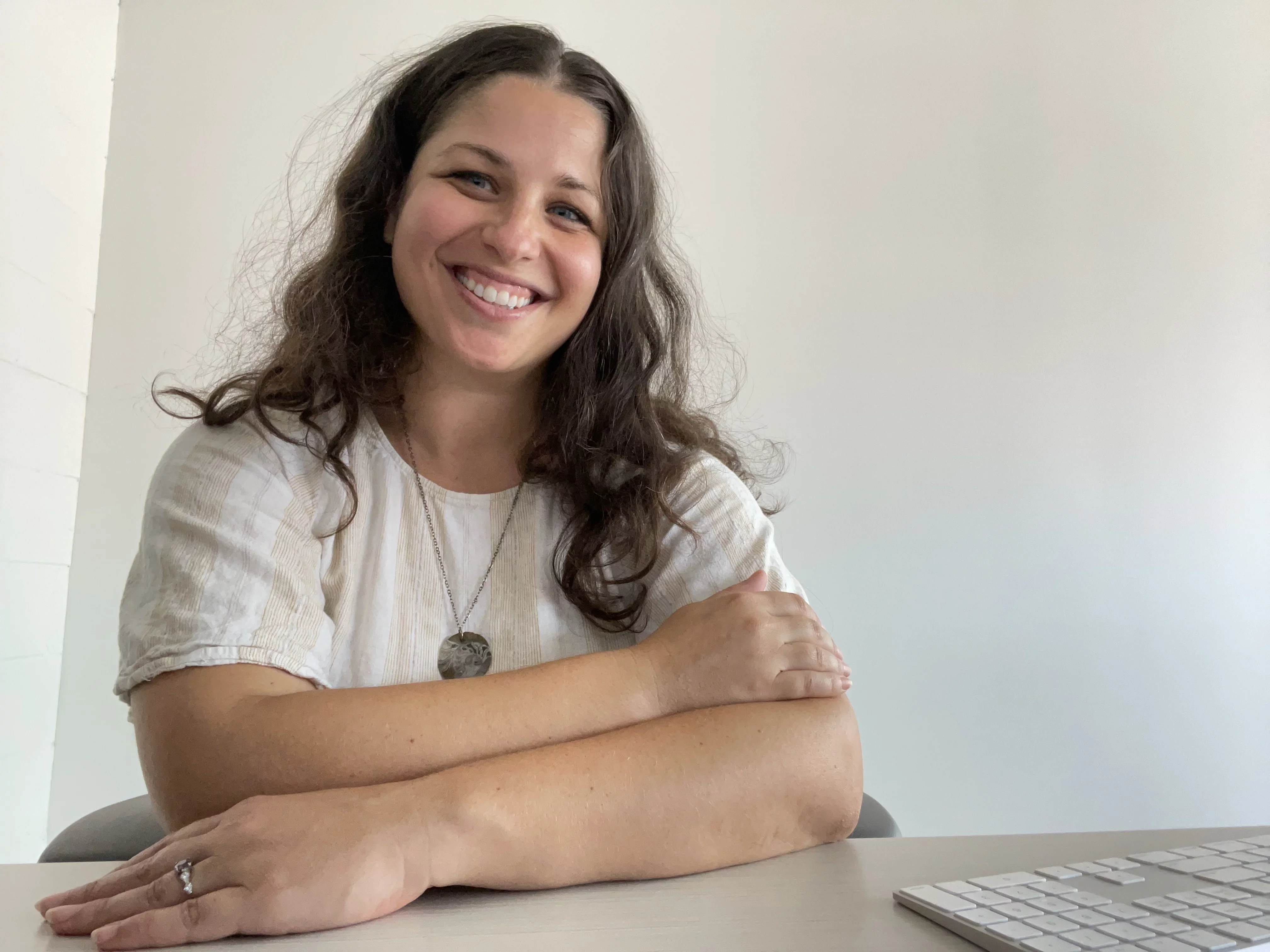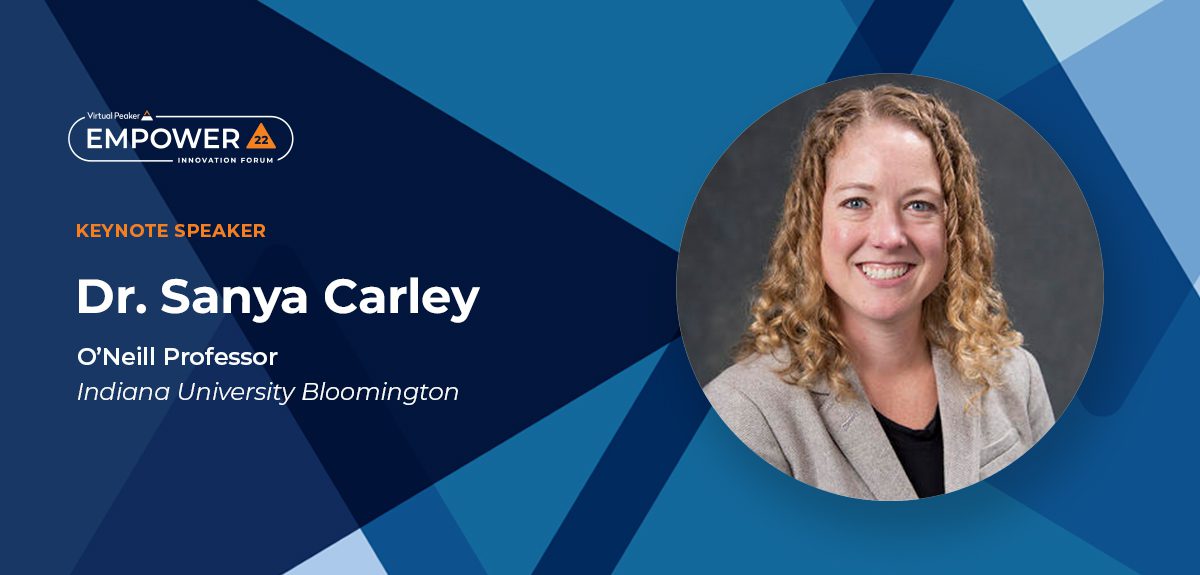In this latest installment of our Q&A series, we’re speaking to Dr. Sanya Carley from Indiana University, who will be one of the keynote speakers at Virtual Peaker’s upcoming 2022 Empower Innovation Forum, an event put together for our clients. Her research focuses on energy justice, energy equity, and policies aimed at advancing the innovation of low-carbon and efficient energy technologies in both the electricity and transportation sectors.
As part of Indiana University’s Energy Justice Lab, Dr. Carley and collaborators study the incidence of energy insecurity among U.S. households and the equity and justice dimensions of the U.S. energy transition. She evaluates the effects, design, and unintended consequences of renewable portfolio standards, corporate average fuel economy standards, and net energy metering standards. She also hosts the podcast, Just Energy, which focuses on the human dimensions of our energy systems and features leaders in the energy justice space who are making profound changes.
What is energy justice and energy equity research?
At IU’s Energy Justice Lab, where I am co-director with Dr. David Konisky, we work on issues related to justice and equity as part of the ongoing energy transition to lower carbon and less carbon-intensive industries. Our research focuses on which populations are most vulnerable to the adverse effects of the clean energy transition, dissects which communities stand to benefit and which do not and aims to understand who’s involved in decision-making processes. We also work on categorizing different policies and practices that are in place to be more inclusive and equitable, identifying geographically where they exist as well as how they are implemented.
Some of our research focuses specifically on disadvantaged communities from an employment perspective, for example, which communities might lose employment due to moving toward cleaner technologies. We’re working on a major project right now on the transition toward electric vehicles in the Midwest and what the implications are for autoworkers. We also have a large body of work on energy insecurity, and thinking about those populations that are struggling to pay their energy bills, and seeking to avoid utility disconnection. These are just some examples of the work we’re doing under the umbrella of energy justice and energy equity at the IU lab.
How do energy justice and decarbonization intersect?
What typically happens is that stakeholders aim for decarbonization and for modernizing energy systems and business, but equity is generally just an afterthought. We assume those adversely affected are given extra resources, but oftentimes they’re not, and in our work what we’re advocating for is an equity-first approach. Then from the get-go, you’re thinking: what are the consequences for different demographic groups, and who is involved in planning and decisions about our energy systems?
So, an example of that, and this is from a report we just published, is with respect to the new electric vehicles industry. In this report, we highlight that some companies are thinking with this early-stage innovation about how to extend the benefits of EVs to disadvantaged and low-income communities. They’re thinking about how these communities might face even deeper barriers to EVs because, for example, they can’t carry credit, or they aren’t currently paying enough taxes to receive the tax credit to assist with an EV purchase.
And the challenge for these companies, as well as the government, is how to provide extra resources, and how to improve their infrastructure to make sure they also have charging capabilities and can overcome these barriers. In the report, we provide several ways to do so. And this is an example of how to approach topics with an equity-first approach.
How can utilities impact energy justice?
Utilities are a crucial stakeholder, and they have a huge role to play in thinking about how to extend clean energy technologies to traditionally underserved communities. They can certainly be on the front lines including by encouraging community involvement in utility decision-making, and by providing relief to consumers who are struggling with energy insecurity. These efforts can also sync in lockstep with decarbonization goals, for instance, through the provision of solar panels, or weatherization and energy efficiency upgrades. There’s a huge role for utilities to play, but it may require thinking outside of the box and working closely with local stakeholders.
How are utilities engaging with low-income communities?
It is important to involve the local community in the messaging and outreach around utility initiatives. In a lot of communities, the trust level for their local utility is low, and frankly, often for good reasons because of decades of poor service and treatment. Often, the only touch point they have with utilities is centered around their service being disconnected or through their utility bills. So engaging local community members, and making sure those community members are part of the recruitment – and are paid for their efforts- is an example of how to increase that trust.
– Dr. Sanya Carley, Faculty Director of the Kleinman Center and Presidential Distinguished Professor of Energy Policy and City Planning at the Stuart Weitzman School of Design
I also should point out, partnering with researchers can also help uncover what helps break the cycle of energy insecurity. Partnerships with researchers in utility programs – weatherization or heat pump retrofitting programs – with pre-and post-studies can uncover what kinds of interventions work. For researchers, it’s hard to deeply engage with utilities on these issues, but we do know from research that when utilities take a research-minded and equity-first approach, programs are more successful in reaching their goals, and partnerships can help reveal this.
For example, the IU Energy Justice Lab is in an early partnership with the city of Cincinnati, which has a program called WarmUp Cincy. It’s focused on helping residents with weatherization and energy insecurity. One of the neatest things about this project is that there are so many partners of all different types – utilities, nonprofit organizations, government agencies – and all of the parties are coming together to both implement energy efficiency programs, help low-income customers, support decarbonization goals, and all with an equity-first approach.
How does rate design impact energy equity?
Different places think they’re doing well with rate design, but we still don’t have a good grasp of what is a good rate from an equity perspective. I think that’s where research is lagging, albeit growing, but we could certainly learn from utilities and utility commissions what they think is working – that is so fundamental.
In our lab, we have conducted many interviews with households that have been disconnected, and one interview that sticks out in my head regularly is this one: We were speaking with a gentleman who had a smart meter because his local utility was rolling out smart meters for the entire rural population. The cost for that meter was simply added as a rider to his bill, increasing it in a meaningful way for him. In one month, he was 13 dollars overdue, and the utility disconnected him, which they could now do remotely without even coming to his home or having any kind of personal interaction.
Upon reconnection, the utility did the same thing – they took care of it remotely. This, to me, is an example of a technology that has great intentions, but in the broader systems and with the rate designs set up, really caused energy vulnerability and frankly an impersonal and trust-losing experience for the utility, and a highly traumatic experience for this individual and his family.
Are there differences in the way that different types of utilities – munis vs coops vs IOUs – approach equity?
The objectives of different utilities are important – for IOUs, it’s cost minimization and profit maximization; for municipalities, it’s more about covering their costs; for cooperatives, it’s also covering their costs, but also more community-oriented. But for all of these, there’s a huge asterisk because it depends on the cooperative. It almost seems to me that if you’ve met one cooperative – you’ve met one cooperative. You know, they’re all just so profoundly different.
Conclusion: Dr. Sanya Carley & Energy Justice
The clean energy transition – one where distributed energy helps utilities meet their decarbonization goals – requires collaboration, innovation, and creative action from stakeholders across many different sectors, including researchers like Dr. Sanya Carley and her colleagues at IU’s Energy Justice Lab. At Virtual Peaker, our energy management platform encourages utilities to leverage new, cost-effective sources of clean and renewable power generation that help build trust with their members.
As these consumers change the ways they use and manage energy, utilities are seeking innovative ways to transition to cleaner energy sources by adopting technologies that manage DER assets. We’re excited to highlight Dr. Carley’s work and continue to engage with how the energy transition can be more equity-first in providing access and benefits from clean technologies like smart thermostats, heat pump water heaters, electric vehicles, and home solar and energy storage.







